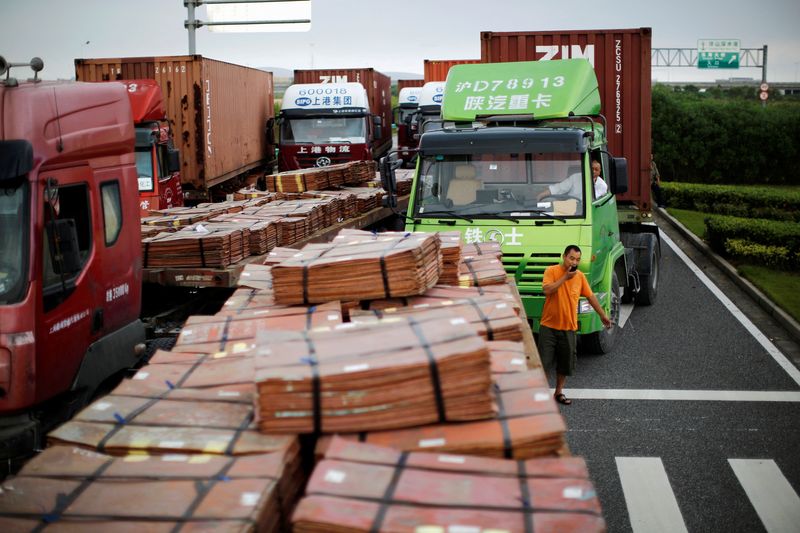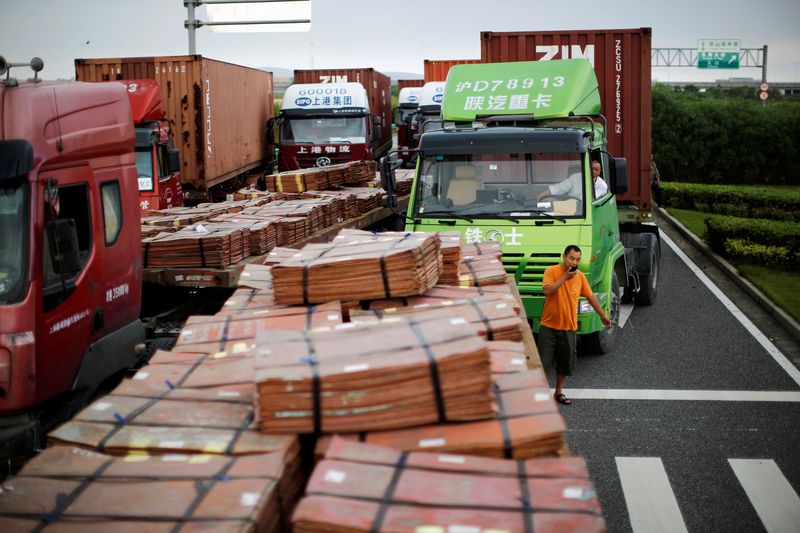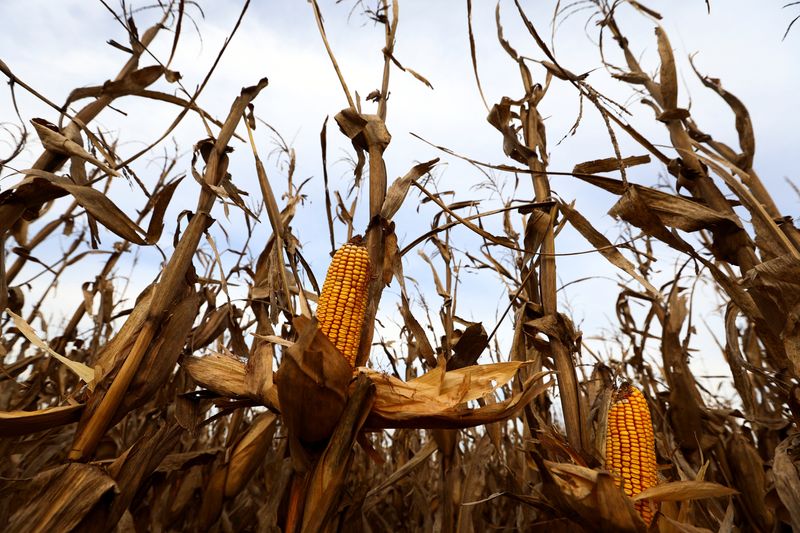Commodities
Russia and China trade new copper disguised as scrap to skirt taxes, sanctions

(Reuters) – Russian Copper Company (RCC) and Chinese firms have avoided taxes and skirted the impact of Western sanctions by trading in new wire rod disguised as scrap, three sources familiar with the matter told Reuters.
Copper wire rod was shredded in the remote Xinjiang Uyghur region by an intermediary to make it hard to distinguish from scrap, the sources said, allowing both exporters and importers to profit from differences in tariffs applied to scrap and new metal, the sources said.
Russia’s export duty on copper rod was 7% in December, lower than the 10% levy on scrap. Imports of copper rod into China are taxed at 4%, and there is no duty on Russian scrap imports.
The sales of new metal disguised as scrap, which started in December, are reflected in a discrepancy between Chinese and Russian data.
Chinese customs data showed China has bought significantly more copper scrap from Russia since December, while Russian figures Reuters obtained from a commercial data provider showed the amount of scrap exported to the country’s biggest trade partner was negligible.
In response to a Reuters’ inquiry on the discrepancy, Russian customs said: “The Federal customs service temporarily does not provide data on foreign trade.” It stopped publishing trade data in April 2022 shortly after Russia’s invasion of Ukraine. Since then, the market has relied on commercial providers.
Asked about the trade in copper rod to Chinese firms, RCC, which is subject to Western sanctions, said that it supplies products only to Russian companies. It did not comment further.
China’s customs in Xinjiang, which borders Russia, did not respond to an emailed inquiry and a telephone call.
China has become a major destination for Russian companies seeking to export their commodities after the United States imposed sanctions on Russia for its invasion of Ukraine in February 2022.
The United States and the European Union have imposed sanctions on Chinese companies for supporting Russia’s war effort in Ukraine.
DISGUISE
Shredding newly-made copper wire rod is an effective way to disguise new material that looks very different to scrap.
The new, high-purity copper long, thin rods, mainly used for making power cables, are typically coiled for ease of transport.
Copper scrap, by contrast, is a mix of wires, tubes and pipes that have already been used. They are chopped into grain-sized pieces or coiled and pressed, like packs of noodles, for transport.
The shredding had escaped notice as China has restricted access to the Xinjiang region in response to international condemnation of Uyghur repression, the sources said.
Apart from the financial incentive of avoiding taxes, the shredded metal is harder to identify and trace – making it easier to sell to Chinese manufacturers.
Theoretically, there are no legal obstacles to prevent China from buying metal from Russian firms under Western sanctions, but manufacturers may still be wary of losing export business to buyers seeking to avoid providing any funds to Russia.
Sanctions can also mean difficulties with processing payments and borrowing money. The sources said some Chinese companies have set up new teams to deal with Russian-related business.
‘DE FACTO COPPER ROD’
Last December, according to a commercial data provider Chinese companies made a total of five purchases of products labelled as “copper rod” from RCC’s plant in the Urals region. The purchases made by a United Arab Emirates-based entity called Modern Commodity Trading DMCC, generated revenues of roughly $65 million, according to the commercial data provider.
The UAE-based firm could not be reached for comment.
Russia has never been a major seller of scrap copper to China.
However, from December last year, China’s copper scrap imports from Russia rose significantly, customs data showed.
Most of that, 97% or 6,434 metric tons, came through the Alashankou border of Xinjiang in December.
Russian data showed a mismatch, indicating the country sold only 73 tons of copper scrap to China in the same month.
In 2021 and 2022, an average of 95.3 tons and 125 tons of Russian copper scrap were sold to China each month.
Volumes rose sharply over the last few months with monthly imports reaching 11,599 tons by February 2024.
Customs data on Chinese imports of copper wire rod is not publicly available.
“This scrap from Russia is de facto copper rod, but not declared as rod. I cannot disclose any more detail,” said a Chinese manufacturing source who asked to remain anonymous. The source added the material could be directly consumed by copper fabricators in Jiangsu and Zhejiang provinces.
While Russian data showed minimal scrap exports, a sudden increase in wire rod exports occurred in December.
According to the data, “Kyshtym Copper Electrolyte Plant JSC,” a plant run by RCC delivered 8,041 tons of copper wire rod to China via Alashankou in Xinjiang in December compared with only 1,618 tons in November.
“As of today, Kyshtym Copper Electrolyte Plant sells its products only to domestic companies,” the Kyshtym plant said in a response to Reuters questions on its sales to China.

“We have not monitored the products’ further fate, so I have nothing to add to what has already been said.”
(This story has been refiled to fix the spelling to ‘Uyghur’ from ‘Uygur’, in paragraphs 2 and 14)
Commodities
As climate shifts, a leafhopper bug plagues Argentina’s corn fields

By Maximilian Heath and Matias Baglietto
CORDOBA PROVINCE, Argentina (Reuters) – Global warming has brought Argentina’s corn farmers a dangerous new enemy: a yellow insect just four millimeters (0.16 inch) long that thrives in hotter temperatures and is threatening harvests of the crop. Meet the leafhopper.
The world’s No. 3 corn exporting country has slashed millions of tons from its harvest projections for the current crop due to a rare plague of the insect that can carry a stunt disease that damages the cobs and kernels of the plant.
Farmers fear such infestations could become more regular, with fewer frosts in recent years to check the insect’s spread, and forecasts for a warm winter ahead, farmers, weather experts and data analyzed by Reuters showed.
Some farmers already have said they will sow less corn for next season in favor of other crops such as soy, the South American country’s main cash crop, which is not affected by the bugs.
“Many are going to reduce their hectares of corn to zero,” said Anibal Cordoba, a producer in northern Chaco province, adding a hard freeze this winter is needed or leafhopper numbers will explode again next season.
“You normally found leafhoppers in the bud of the plants if you looked. But this year you go to the field and you find clouds of leafhopper. It’s just crazy.”
Agriculture and climate experts linked the unusual outbreak to rising global and local temperatures.
“The number of days with frost is becoming less frequent due to global temperatures rising,” said climate change specialist Matilde Rusticucci at the University of Buenos Aires, adding minimum temperatures in the country had “increased steadily”.
remove ads
.
“The year 2023 was declared the warmest year in history,” Rusticucci said. This helped leafhoppers spread far beyond the warmer northern regions where they usually thrive and where farmers have adapted. Some 10 million tons of Argentine corn production has been lost already, and analysts say it could fall further.
“We should be talking about an Argentine production of more than 60 million tons of corn and because of this insect we are talking about 50.5 (million tons),” said Cristian Russo, head of agricultural estimates at the Rosario grains exchange (BCR).
“We all suspect that it still could get much worse than what we’re seeing,” he added. “It’s a big blow to corn.”
According to Russo, leafhopper numbers in northern Argentina are 10 times the normal level, while the insect has been found nearly 1,500 kilometers (932 miles) south of traditional areas, where previously it had been too cold.
Argentina’s government, which did not respond to a request for comment on this story, has looked to speed authorization for pesticides to fight leafhoppers and recently met with farm associations to coordinate how to mitigate leafhopper damage.
‘THIS IS A REAL, REAL PROBLEM’
In parts of Argentina, frosts have actually increased in recent winters, but some key farming areas have had a substantial decline. Nationally, minimum temperatures have been rising and cold nights decreasing over decades.
A study by scientists at Argentine universities and state institutes showed that from 1963 to 2013 the average number of cold nights decreased from 15 days per year to around eight.
remove ads
.
Fewer frosty nights help leafhoppers, which cannot tolerate temperatures below 4 degrees Celsius, said Fernando Flores, entomologist at the National Institute of Agricultural Technology (INTA).
“One of the most important causes of the big increase in (insect) numbers was the decrease in the number of frosts in the country the previous winter,” Flores said.
In western central Cordoba province, the main corn region of Argentina, the provincial grain exchange has estimated leafhopper-related corn losses of $1.13 billion. Data from the Cordoba observatory show frosts down steadily over decades.
“What was planted late towards the end of December, beginning of January, was where the greatest damage was seen,” said Ramón Garcia, a farmer from the Cordoba farm town of Marcos Juarez. “There was a significant drop in yield.”
The outlook ahead is tough. Rusticucci said January, February and March 2024 already set records for global maximum temperatures.
Michael Cordonnier, Illinois-based agronomist at consultancy Soybean and Corn Advisor Inc, said what had happened with corn in Argentina was “very unusual” and it would take time for farmers there to adapt, as farmers in warmer corn-growing areas like Brazil have adapted over years.
“This is a real, real problem. Going forward, they will be able to solve this a few years down the road by getting hybrids that are more tolerant to corn stunt disease and registering more insecticides for this specific problem,” he said.
“But for the time being it’s just terrible.”
Commodities
Oil steadies as weak physical markets balance Middle East tensions

By Alex Lawler and Deep Kaushik Vakil
LONDON (Reuters) -Oil steadied on Tuesday as weakness in the physical market countered concern about conflict in the Middle East as Israel stepped up attacks in southern Gaza and a ceasefire deal between Hamas and Israel hung in the balance.
The Israeli military seized control of the Rafah border crossing between the Gaza Strip and Egypt and its tanks pushed into the southern Gazan town of Rafah, as mediators struggled to secure a ceasefire agreement.
futures were down 30 cents, or 0.4%, at $83.03 a barrel by 1130 GMT while U.S. West Texas Intermediate (WTI) crude futures fell 27 cents, or 0.3%, to $78.21.
“Truce remains elusive, and even if it is reached the question remains whether Houthi hostilities in the Red Sea would cease and the Suez Canal would reopen, significantly mitigating the risk of shipping throughout the region,” said Tamas Varga of oil broker PVM.
“I believe the lack of optimism of the past few days is more the result of genuine weakness in the physical markets.”
In a sign of easing concern that supply could tighten, the first-month Brent contract’s premium to the six-month contract slipped to $2.89 a barrel for its lowest since mid-February.
“Trying to use geopolitics as an excuse to buy crude oil has become an increasingly futile and costly affair for traders in recent months,” said Ole Hansen of Saxo Bank, adding that the drop in crude spreads highlights “a well supplied market, leaving the upside capped for now”.
remove ads
.
Last week Brent and WTI had registered their steepest weekly losses in three months as the market focused on weak U.S. jobs data and the possible timing of a Federal Reserve interest rate cut.
A stronger dollar also weighed, making crude more expensive for traders holding other currencies.
As well as Middle East tensions, the latest U.S. inventory reports will also be in focus.
oil and product stockpiles were expected to have fallen last week, a Reuters poll showed. Crude inventories could have fallen by about 1.2 million barrels in the week to May 3, based on analyst forecasts. [EIA/S]
Saudi Arabia’s move to raise official selling prices for its crude sold to Asia, Northwest Europe and the Mediterranean in June also supported prices, signalling expectations of strong demand this summer.
Commodities
Oil prices slip lower; Israel-Hamas ceasefire talks, US inventories in focus

Investing.com– Oil prices edged lower Wednesday amid uncertainty over global production as a potential Middle East ceasefire hangs in the balance.
At 08:40 ET (12:40 GMT), fell 0.5% to $82.91 a barrel, while dropped 0.6% to $78.04 a barrel.
Israel-Hamas ceasefire deal remains elusive
Palestinian militant group Hamas on Monday agreed to a Gaza ceasefire proposal from mediators, but Israel said the terms did not meet its demands and undertook strikes on the city of Rafah, in southern Gaza.
While Israel was still seen preparing for ceasefire negotiations later, the recent escalation in military action showed little actual progress towards a deal.
A lack of settlement between the parties in the now seven-month long conflict has supported oil prices, as investors worry regional escalation of the war will disrupt Middle Eastern crude supplies.
That said, little actual disruption has been seen to date, and the benchmarks posted the steepest weekly losses in three months last week as investors worried about the prospect of higher-for-longer interest rates curbing growth in the U.S., the top global oil consumer.
Russia to agree to lift production?
The market has edged lower Tuesday after news reports said Russian Deputy Prime Minister Alexander Novak indicated OPEC+ could move to raise crude production.
The Organization of the Petroleum Exporting Countries and allies, known as OPEC+, are making voluntary output cuts totalling about 2.2 million barrels per day for the first half of 2024, on top of earlier reductions announced in various steps since late 2022, bringing the total pledged cuts to just under 6 million barrels per day.
remove ads
.
Bloomberg reported Monday that Russia’s oil and gas revenues doubled in April despite sanctions, creating room for Moscow to agree raise output, even is prices suffer as a consequence.
OPEC+ is scheduled to meet on June 1 in Vienna to decide its next output policy steps.
US inventories data due
As well as Middle East tensions, the latest U.S. inventory reports will also be in focus Tuesday.
The releases its weekly forecasts of U.S. crude oil and product stockpiles later in the session, and these are expected to have fallen.
stockpiles sprung a surprise increase the previous week, the API reported last week, with inventories rising by about 4.9 million barrels for the week ended April 26.
The Energy Information Administration will also publish its latest later in the session, which will include the EIA’s latest views on the global oil market, and its latest forecast for U.S. oil and gas production for the remainder of this year and 2025.
(Ambar Warrick contributed to this article.)

 Forex2 years ago
Forex2 years agoForex Today: the dollar is gaining strength amid gloomy sentiment at the start of the Fed’s week

 Forex2 years ago
Forex2 years agoHow is the Australian dollar doing today?

 Forex1 year ago
Forex1 year agoUnbiased review of Pocket Option broker

 Forex2 years ago
Forex2 years agoDollar to pound sterling exchange rate today: Pound plummeted to its lowest since 1985

 Cryptocurrency2 years ago
Cryptocurrency2 years agoWhat happened in the crypto market – current events today

 World2 years ago
World2 years agoWhy are modern video games an art form?

 Stock Markets2 years ago
Stock Markets2 years agoMorgan Stanley: bear market rally to continue

 Economy2 years ago
Economy2 years agoCrude oil tankers double in price due to EU anti-Russian sanctions

































